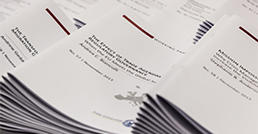New Working Papers Published
Jun 08, 2017
Working Papers
Image Credit: Business Fotografie Inga Haar www.business-fotografie.de/
We have recently published two new working papers: Working Paper No. 78 by Mor Mitrani and Working paper No. 79 by Brooke Coe.
Working Paper No. 78 "The Discursive Construction of the International Community: Evidence from the United Nations General Assembly"
Mor MitraniThe idea that states can hold common values and standards of conduct as well as some capacity to act in the international arena in collective manners for collective goals is epitomized in the concept of international community. Although the term is widely used by scholars, practitioners, and international political leaders and is an integral part of the common international vocabulary, only few have sought to define it, identify its members, and characterize its ways of actions and sources of legitimacy. This paper asks: Who is the international community? Taking a socio-discursive approach, I argue that the international community is essentially a construct that does not exist beyond the discursive level, namely that it materializes only when political agents talk about it, refer to it, and attribute to it certain values, rules, and virtues. I present here the findings of an automated text analysis of 4264 states’ speeches at the United Nations General Assembly (UNGA) that point to the prevalence of the international community in the international discourse and reveal the main topics that are associated with it. These findings illuminate salience patterns in the discursive construction of the international community and shed light on its function as a legitimacy framework for international action.
Click here to view this working paper.
Working Paper No. 79 "Collective Regional Image: Logics of Consciousness and Modes of Management in Post-Cold War Africa and Southeast Asia"
Brooke CoeOne distinguishing feature of the “new” regionalism is its outward orientation – the increased importance of the external dimension of regional cooperation. It makes sense, then, that efforts to manage external perceptions of a region, on the part of policy-relevant actors in that region, might contribute to important changes to regional norms and institutions. By and large, though, existing accounts of normative and institutional change at the regional level do not explicitly conceptualize and theorize collective image consciousness and management. This paper offers an initial attempt to address this conceptual gap, making use of two cases of regional image crisis (post-Cold War Africa and post-1997 Southeast Asia) in order to draw out logics of regional image consciousness and to distinguish among types of regional image management efforts. As regional communities of states, Africa and Southeast Asia promoted and adhered to a relatively strict interpretation of the principle of non-interference during the Cold War period. In the post-Cold War era, the non-interference norm has eroded in both regions. In each, these developments constituted – in part – a collective image management strategy, aimed at external audiences. Reforms to regional institutions were promoted in part as efforts to ameliorate negative international perceptions.
Click here to view this working paper.
